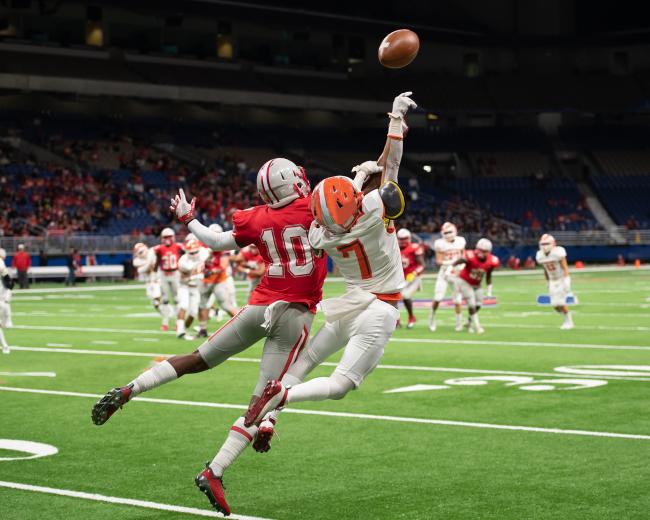Effects of repeated head trauma in young athletes
November 19, 2025
Effects of repeated head trauma in young athletes
At a Glance
- Researchers gained new insights into the changes in the brains of young athletes that may lead to chronic traumatic encephalopathy.
- The findings suggest that repetitive head impacts cause brain changes much earlier than previously thought.

People can be exposed to repetitive impacts to the head in contact sports, military service, falls, and other situations. Repeated head trauma raises the risk of developing chronic traumatic encephalopathy (CTE), a progressive degenerative disease that can bring problems with thinking, understanding, and communicating. It may also cause movement disorders, problems with impulse control, depression, mood swings, confusion, and irritability.
Currently, CTE is only definitively diagnosed after death by analyzing donated brain tissue samples. The disease is marked by the buildup of a protein called p-tau in neurons around blood vessels, particularly deep in the grooves on the brain’s surface, called sulci.
A research team led by Dr. Jonathan D. Cherry from Boston University set out to gain a better understanding of the brain changes that lead up to CTE. They examined single cells in the sulci of autopsied brain tissue from 28 men, aged 20 to 51 years. Eight of the samples came from men who didn’t play contact sports, 9 from men who played American football and soccer but weren’t diagnosed with CTE, and 11 from men who played contact sports and were diagnosed as having low-stage CTE. The study was published in Nature, in August 2025.
The researchers saw several changes in the brains of athletes who participated in contact sports, whether or not they were diagnosed with CTE. Inflammatory microglia—immune cells that act as first responders—were more numerous in the examined brain regions of those who participated in contact sports. Changes were also seen in genes expressed in the brain’s blood vessels. In addition, the team found 56% fewer of the neurons that transmit nerve signals in the examined brain sulci of those who participated in contact sports. The neuron density in this region dropped with the years of contact sports played.
The team found no association, however, between neuron loss and p-tau levels. This suggests that the loss of neurons begins before p-tau builds up in the depths of the brain’s sulci, the signature sign of CTE.
Next, the scientists compared which signaling molecules and their receptors were boosted and in which cells. They identified a signaling molecule, called TGFB1, that seems to play an important role. Produced by microglia, it signals to various other cells through different receptors in response to head trauma. The team also found signaling differences between the athletes who played contact sports but weren’t diagnosed with CTE and those who were diagnosed with CTE.
Additional studies in more athletes will be needed to confirm these results and gain more insights into the molecular mechanisms that lead to CTE.
“These results highlight that even athletes without CTE can have substantial brain injury,” Cherry says. “Understanding how these changes occur, and how to detect them during life, will help the development of better prevention strategies and treatments to protect young athletes.”
—by Yolanda L. Jones, MS, MBA
Related Links
- Chronic Traumatic Encephalopathy in Young Athletes
- How Football Raises the Risk for Chronic Traumatic Encephalopathy
- Testing a Blood Biomarker for Neurodegeneration
- Nanoparticles Developed for Traumatic Brain Injury
- Biomarkers Predict Concussion Recovery Time
- Blood Proteins Associated with Persistent Symptoms after Brain Injury
- Tiny Bleeds Associated with Disability after Brain Injury
- Many with Mild Traumatic Brain Injury Don’t Receive Follow-up Care
- Caring for Concussions: More Than a Bump on the Head
- Traumatic Brain Injury (TBI)
- Facts About TBI (CDC)
References
Repeated head trauma causes neuron loss and inflammation in young athletes. Butler MLMD, Pervaiz N, Breen K, Calderazzo S, Ypsilantis P, Wang Y, Breda JC, Mazzilli S, Nicks R, Spurlock E, Hefti MM, Fiock KL, Huber BR, Alvarez VE, Stein TD, Campbell JD, McKee AC, Cherry JD. Repeated head trauma causes neuron loss and inflammation in young athletes. Nature. 2025 Sep 17. doi: 10.1038/s41586-025-09534-6. Epub ahead of print. PMID: 40963024.
Funding
NIH’s National Institute on Aging (NIA) and National Institute of Neurological Disorders and Stroke (NINDS); U.S. Department of Veterans Affairs.


